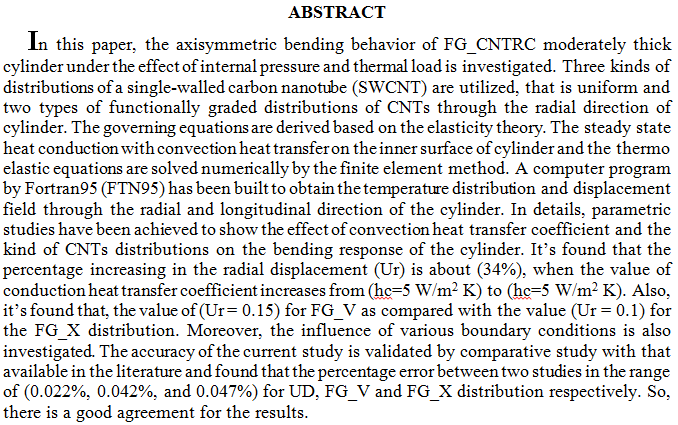
Ternary polymer blend of chitosan/poly vinyl alcohol/ poly vinyl pyrrolidone was prepared by solution castingmethod, nanocomposite was prepared by sonication method with nano Ag and Zn. All prepared compounds have been characterizedby FT-IR, SEM, DSC, as well as Biological activity. Antimicrobialactivity related to prepared blendsand Nanocomposites againstsix types of bacteria namely, Staphylococcus aureas, E. faecalis, S.typhi, P. aeruginosa, Bacillus subtilis, Escherichia coli andC. albicans fungal were examined and evaluated. The results reveal that the prepared polymer blends and nanocompositeshavegood antimicrobial activity against all kinds of microbials.
Poly urea formaldehyde –Bentonite (PUF-Bentonite) composite was tested as new adsorbent
for removal of mefenamic acid (MA) from simulated wastewater in batch adsorption
procedure. Developed a method for preparing poly urea formaldehyde gel in basic media by
using condensation polymerization. Adsorption experiments were carried out as a function of
water pH, temperature, contact time, adsorbent dose and initial MA concentration .Effect of
sharing surface with other analgesic pharmaceuticals at different pH also studied. The
adsorption of MA was found to be strongly dependent to pH. The Freundlich isotherm model
showed a good fit to the equilibrium adsorption data. From Dubinin–Radushkevich model the
mean free
 (3)
(3)
 (2)
(2)
 (4)
(4)
Recent years have witnessed an increase in the use of composite coatings for numerous applications, including aerospace, aircraft, and maritime vessels. These materials owe this popularity surge to the superior strength, weight, stiffness, and electrical insulation they exhibit over conventional substances, such as metals. The growing demand for such materials is accompanied by the inevitable need for fast, accurate, and affordable nondestructive testing techniques to reveal any possible defects within the coatings or any defects under coating. However, typical nondestructive testing (NDT) techniques such as ultrasonic testing (UT), infrared thermography (IRT), eddy current testing (ECT), and laser shearography (LS) have failed to p
... Show More (25)
(25)
 (24)
(24)
In this study, the preparation and characterization of hyacinth plant /chitosan composite, as a heavy metal removal, were done. Water hyacinth plant (Eichhorniacrasspes) was collected from Tigris river in Baghdad. The root and shoot parts of plant were ground to powder. Composite materials were prepared at different ratios of plant part (from 2.9% to 30.3%, wt /wt) which corresponds to (30-500mg) of hyacinth plant (root and shoot) and chitosan. The results showed that all examined ratios of plant parts have an excellent absorption to copper (Cu (II)). Moreover, it was observed that 2.9% corresponds (30mg) of plant root revealed highest removal (82.7%) of Pb (II), while 20.23% of shoot removed 61% of Cd (II) within 24 hr
... Show More (8)
(8)
 (5)
(5)
The synthesis of new substituted cobalt Phthalocyanine (CoPc) was carried out using starting materials Naphthalene-1,4,5, tetracarbonic acid dianhydride (NDI) employing dry process method. Metal oxides (MO) alloy of (60%Ni3O4 40%-Co3O4 ) have been functionalized with multiwall carbon nanotubes (F-MWCNTs) to produce (F-MWCNTs/MO) nanocomposite (E2) and mixed with CoPc to yield (F-MWCNT/CoPc/MO) (E3). These composites were investigated using different analytical and spectrophotometric methods such as 1H-NMR (0-18 ppm), FTIR spectroscopy in the range of (400-4000cm-1), powder X-rays diffraction (PXRD, 2θ o = 10-80), Raman spectroscopy (0-4000 cm-1), and UV-Visib
... Show More (8)
(8)
 (7)
(7)
A novel demountable shear connector is proposed to link a concrete slab to steel sections in a way that resulting steel-concrete composite floor is demountable, i.e. it can be easily dismantled at the end of its service life. The proposed connectors consist of two parts: the first part is a hollow steel tube with internal threads at its lower end. The second part is a compatible partially threaded bolted stud. After linking the stud to the steel section, the hollow steel tube can be fastened over the threaded stud, which create a complete demountable shear connector. The connector is suitable for use in both composite bridges and buildings, and using cast in-situ slabs, precast solid slabs, or hollow-core precast slabs. A series of push-off
... Show More (1)
(1)
 (1)
(1)
The increasing demand for energy has encouraged the development of renewable resources and environmentally benign fuel such as biodiesel. In this study, ethyl fatty esters (EFEs), a major component of biodiesel fuel, were synthesized from soybean oil using sodium ethoxide as a catalyst. By-products were glycerol and difatty acyl urea (DFAU), which has biological characteristics, as antibiotics and antifungal medications. Both EFEs and DFAU have been characterized using Fourier transform infrared (FTIR) spectroscopy, and 1H nuclear magnetic resonance (NMR) technique. The optimum conditions were studied as a function of reaction time, reactant molar ratios, catalyst percentage and the effect of organic solvents. The conversion ratio of soybea
... Show More (10)
(10)
 (15)
(15)
 (15)
(15)
